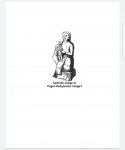Mashah ban yasharal
New Lister
SOURCE: THE TWO BABYLONS BY ALEXANDER HISLOP, pg 93
Then look at Easter. What means the term Easter itself? It is NOT a Christian name. It bears its Chaldean origin on its very forehead. Easter is nothing else than Astarte, one of the titles of Beltis, the queen of heaven, whose name, as pronounced by the people Nineveh, was evidently identical with that now in common use in this country. That name, as found by Layard on the Assyrian monuments, is ISHTAR.
The festival, of which we read in Church history, under the name of Easter, in the third or fourth centuries, was quite a different festival from that now observed in the Romish Church, and at that time was NOT known by any such name as Easter. It was called Pasch, or the Passover, and though not of Apostolic institution, * was very early observed by many professing Christians, in commemoration of the death and resurrection of Christ.
* Socrates, the ancient ecclesiastical historian, after a lengthened account of the different ways in which Easter was observed in different countries in his time--i.e., the fifth century--sums up in these words: "Thus much already laid down may seem a sufficient treatise to prove that the celebration of the feast of Easter began everywhere more of custom than by any commandment either of Christ or any Apostle." (Hist. Ecclesiast.) Every one knows that the name "Easter," used in our translation of Acts 12:4, refers not to any Christian festival, but to the Jewish Passover. This is one of the few places in our version where the translators show an undue bias.
GIESELER, speaking of the Eastern Church in the second century, in regard to Paschal observances, says: "In it [the Paschal festival in commemoration of the death of Christ] they [the Eastern Christians] eat unleavened bread, probably like the Jews, eight days throughout...There is no trace of a yearly festival of a resurrection among them, for this was kept every Sunday" (Catholic Church)... ( pg 94)
The popular observances that still attend the period of its celebration amply confirm the testimony of history as to its Babylonian character. The hot cross buns of Good Friday, and the dyed eggs of Pasch or Easter Sunday, figured in the Chaldean rites just as they do now. The "buns," known too by that identical name, were used in the worship of the queen of heaven, the goddess Easter,(pg 96)
To conciliate the Pagans to nominal Christianity, Rome, pursuing its usual policy, took measures to get the Christian and Pagan festivals amalgamated, and, by a complicated but skilful adjustment of the calendar, it was found no difficult matter, in general, to get Paganism and Christianity--now far sunk in idolatry--in this as in so many other things, to shake hands. The instrument in accomplishing this amalgamation was the abbot Dionysius the Little, to whom also we owe it, as modern chronologers have demonstrated, that the date of the Christian era, or of the birth of Christ Himself, was moved FOUR YEARS from the true time.(pg 94)
* CUMMIANUS, quoted by Archbishop USSHER, Sylloge Those who have been
brought up in the observance of Christmas and Easter, and who yet abhor from their
hearts all Papal and Pagan idolatry alike, may perhaps feel as if there were something
"untoward" in the revelations given above in regard to the origin of these festivals. But a
moment's reflection will suffice entirely to banish such a feeling. They will see, that if the account I have given be true, it is of no use to ignore it. A few of the facts stated in these pages are already known to Infidel and Socinian writers of no mean mark, both in this country and on the Continent, and these are using them in such a way as to undermine the faith of the young and uninformed in regard to the very vitals of the Christian faith.Surely, then, it must be of the last consequence, that the truth should be set forth in its own native light, even though it may somewhat run counter to preconceived opinions, especially when that truth, justly considered, tends so much at once to strengthen the rising youth against the seductions of Popery, and to confirm them in the faith once delivered to the Saints.
Then look at Easter. What means the term Easter itself? It is NOT a Christian name. It bears its Chaldean origin on its very forehead. Easter is nothing else than Astarte, one of the titles of Beltis, the queen of heaven, whose name, as pronounced by the people Nineveh, was evidently identical with that now in common use in this country. That name, as found by Layard on the Assyrian monuments, is ISHTAR.
The festival, of which we read in Church history, under the name of Easter, in the third or fourth centuries, was quite a different festival from that now observed in the Romish Church, and at that time was NOT known by any such name as Easter. It was called Pasch, or the Passover, and though not of Apostolic institution, * was very early observed by many professing Christians, in commemoration of the death and resurrection of Christ.
* Socrates, the ancient ecclesiastical historian, after a lengthened account of the different ways in which Easter was observed in different countries in his time--i.e., the fifth century--sums up in these words: "Thus much already laid down may seem a sufficient treatise to prove that the celebration of the feast of Easter began everywhere more of custom than by any commandment either of Christ or any Apostle." (Hist. Ecclesiast.) Every one knows that the name "Easter," used in our translation of Acts 12:4, refers not to any Christian festival, but to the Jewish Passover. This is one of the few places in our version where the translators show an undue bias.
GIESELER, speaking of the Eastern Church in the second century, in regard to Paschal observances, says: "In it [the Paschal festival in commemoration of the death of Christ] they [the Eastern Christians] eat unleavened bread, probably like the Jews, eight days throughout...There is no trace of a yearly festival of a resurrection among them, for this was kept every Sunday" (Catholic Church)... ( pg 94)
The popular observances that still attend the period of its celebration amply confirm the testimony of history as to its Babylonian character. The hot cross buns of Good Friday, and the dyed eggs of Pasch or Easter Sunday, figured in the Chaldean rites just as they do now. The "buns," known too by that identical name, were used in the worship of the queen of heaven, the goddess Easter,(pg 96)
To conciliate the Pagans to nominal Christianity, Rome, pursuing its usual policy, took measures to get the Christian and Pagan festivals amalgamated, and, by a complicated but skilful adjustment of the calendar, it was found no difficult matter, in general, to get Paganism and Christianity--now far sunk in idolatry--in this as in so many other things, to shake hands. The instrument in accomplishing this amalgamation was the abbot Dionysius the Little, to whom also we owe it, as modern chronologers have demonstrated, that the date of the Christian era, or of the birth of Christ Himself, was moved FOUR YEARS from the true time.(pg 94)
* CUMMIANUS, quoted by Archbishop USSHER, Sylloge Those who have been
brought up in the observance of Christmas and Easter, and who yet abhor from their
hearts all Papal and Pagan idolatry alike, may perhaps feel as if there were something
"untoward" in the revelations given above in regard to the origin of these festivals. But a
moment's reflection will suffice entirely to banish such a feeling. They will see, that if the account I have given be true, it is of no use to ignore it. A few of the facts stated in these pages are already known to Infidel and Socinian writers of no mean mark, both in this country and on the Continent, and these are using them in such a way as to undermine the faith of the young and uninformed in regard to the very vitals of the Christian faith.Surely, then, it must be of the last consequence, that the truth should be set forth in its own native light, even though it may somewhat run counter to preconceived opinions, especially when that truth, justly considered, tends so much at once to strengthen the rising youth against the seductions of Popery, and to confirm them in the faith once delivered to the Saints.
Attachments
-
114.1 KB Views: 55
-
140.3 KB Views: 38
-
44.7 KB Views: 42



